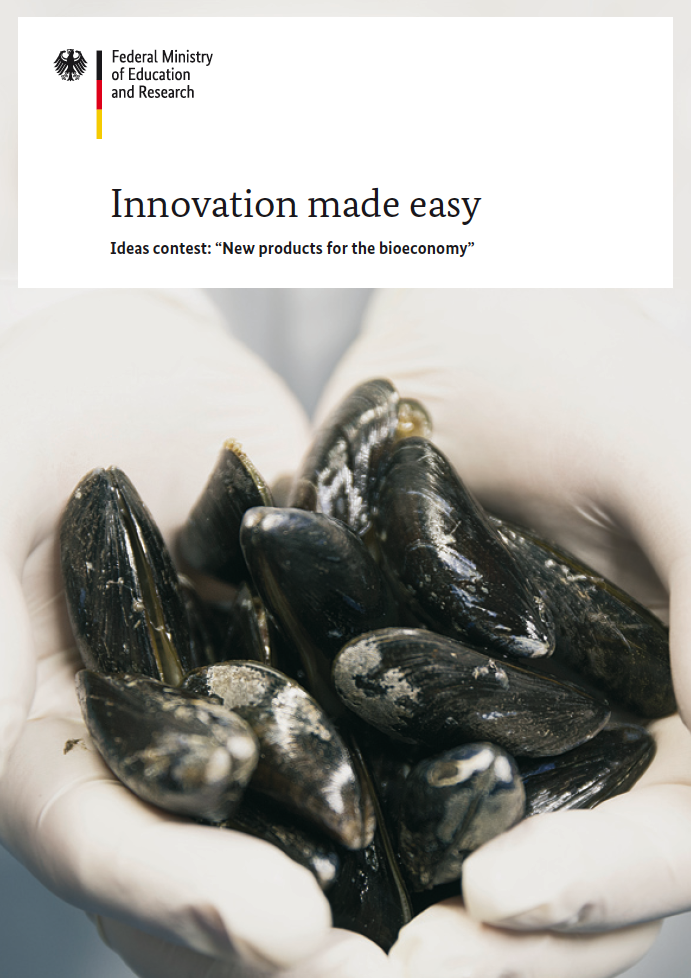12.11.2018 News
Food Animals Biodiversity
Calculating the cod stock
Coastal researchers at the Helmholtz Centre Geesthacht have developed a statistical method with which cod stocks in the Barents Sea can be predicted more accurately.
12.11.2018 News
Food Animals Biodiversity
Coastal researchers at the Helmholtz Centre Geesthacht have developed a statistical method with which cod stocks in the Barents Sea can be predicted more accurately.
07.11.2018 News
Food Animals Agriculture sciences
Essen-based specialty chemicals company Evonik invests in British start-up OPTIfarm, which aims to improve poultry production via digitalisation.
13.11.2018 News
unspecific unspecific unspecific
In early November, international experts from Ghana, Colombia and Germany gathered in Berlin to discuss the state of the implementation of the sustainable development goals.

Publication
Ideas contest "New Products for the Bioeconomy"Published by: Federal Ministry of Education and ResearchBerlin; October 2018Produktion: bioökonomie.de / BIOCOM AGThe brochure illustrates how creative ideas can be turned into innovative, biobased products for the bioeconomy – with support of the BMBF as part of the "New products for the bioeconomy" ideas competion.Download PDF
16.11.2018 News
Chemistry Microorganisms Biotechnology/Systems biology
Certain protein fragments give cheese, beer, soy and the likes their characteristic taste. Munich biochemists have developed a new method to identify these fragments.
19.11.2018 News
Food Plants Agriculture sciences
Scientific advisors and a WTO-committee are urging European legislators to revise their verdict regarding GMOs to reflect current scientific knowledge and protect EU trade relations.
04.07.2019 News
Pharmaceutical industry unspecific Biotechnology/Systems biology
Bioengineers at the TU Munich have used artificial DNA to produce a hydrogel that can release several active substances in a specific order.
08.07.2019 News
Automobile Plants Materials sciences
Plastic reinforced with plant fibres will in future be used for lightweight construction in Porsche series production vehicles. Fraunhofer researchers have developed the material.
11.07.2019 News
Chemistry Plants Biotechnology/Systems biology
Microbiologists have discovered how the highly complex multiple sugar Ulvan from sea lettuce is broken down into its components by a dozen enzymes.
16.07.2019 News
unspecific Microorganisms Biotechnology/Systems biology
Bremen microbiologists have researched bacteria in ciliates that live in close symbiosis with their host and perform unusual metabolic functions.
22.07.2019 News
Agriculture and forestry Animals Agriculture sciences
The soldier fly could help solve not one, but two problems of sustainable farming. Using the insect as feed could eliminate organic waste while also reducing the need for imported soya and fish meal.
25.07.2019 News
Consumables Waste Agriculture sciences
Together with European partners, researchers from the Julius Kühn Institute are investigating how far feedstocks for biobased fertilizers are contaminated with pollutants.
17.07.2019 News
Food Microorganisms Biotechnology/Systems biology
The joint venture of Evonik and DSM, Veramaris, has commissioned an industrial plant for the production of algae oil in the United States.
26.07.2019 Studies and statistics
unspecific unspecific Biotechnology/Systems biology
New figures show sustainable growth of the European bioeconomy. The 18.6 million people employed in the various sectors of the bioeconomy generate a turnover of 2.3 trillion euro.
02.08.2019 News
Energy Microorganisms Plant and process engineering
Extremely halophilic archaea have a natural mechanism to mineralize dissolved radioactive ions and prevent leaching.
01.08.2019 News
Chemistry Animals Biodiversity
A German research cooperation has analyzed the toxins of a species of the robber fly and found an underestimated potential for agriculture and pharmaceutical research.
24.07.2019 News
Agriculture and forestry Plants Plant breeding research
Plant researchers at the University of Halle-Wittenberg have compared the immune response of tobacco with thale cress and discovered surprising differences.
06.08.2019 News
Construction Plants Social sciences
Lawns and trees are good for people living in the city - neuroscientists from Heidelberg and Karlsruhe have measured how spending time in green spaces affects the well-being of volunteers.
07.08.2019 News
Agriculture and forestry Plants Agriculture sciences
Plant researchers from Germany have unlocked the genetic potential of old landraces for breeding robust maize varieties that can withstand harsh conditions caused by climate change.
12.08.2019 News
unspecific unspecific unspecific
In marine sediments, not only microorganisms but also chemical processes produce nitrous oxide that is harmful to the climate.
16.08.2019 News
Chemistry Plants Chemistry
A German-Ethiopian research cooperation aims to develop catalysts for the sustainable use of fatty oils from the seeds of Vernonia galamensis.
19.08.2019 News
Agriculture and forestry Plants Biodiversity
Dead or alive? Plant researchers at the University of Osnabrück have developed a method that can save seedbanks a lot of time and effort.
12.08.2019 Success story
Chemistry Microorganisms Biotechnology/Systems biology
Scientists in Berlin have developed an adhesive protein inspired from mussels and are able to produce the substance from reprogrammed microbes. The adhesive can be used as superglue to treat wounds and bone fractures.
15.08.2019 News
Pharmaceutical industry unspecific Biotechnology/Systems biology
Using epigenetic markers in the genome, Fraunhofer researchers can deduce the biological age of a cell sample. The software used is based on AI algorithms.
29.08.2019 News
Chemistry Microorganisms Biotechnology/Systems biology
Fraunhofer researchers are developing processes and catalysts to produce chemicals and fuels from carbon dioxide. They have now demonstrated ethylene synthesis.
12.11.2019 News
Chemistry unspecific Agriculture sciences
Pesticides pose greater risks than previously thought: Helmholtz researchers have shown that pollutants can affect sensitive people and ecosystems even at very low concentrations.
05.11.2019 News
Agriculture and forestry Animals Agriculture sciences
In Germany, most insect groups are affected by species extinction - and more so than previously assumed, as a study led by the Technical University of Munich shows.
13.11.2019 News
Pharmaceutical industry Animals Materials sciences
Researchers have shed light on the structure of nacre in mussels, paving the way for break-resistant ceramic materials.
19.11.2019 News
Agriculture and forestry Plants Agriculture sciences
Researchers from Bonn are hoping to gently optimize weed control in the cultivation of medicinal plants in order to avoid contamination.
20.11.2019 News
Agriculture and forestry Plants Forestry
In addition to softwoods, low-value hardwoods are also suitable for the production of fiberboard. This has been demonstrated by Fraunhofer researchers.
15.11.2019 News
Agriculture and forestry Plants Agriculture sciences
The European Council calls on the European Commission to investigate how the handling of genome-edited plants is to be regulated in future.
25.11.2019 News
Machine and plant engineering Microorganisms Plant and process engineering
Sewage treatment plants often require a lot of space. The Ruhrverband is piloting a new process that saves 30% electricity and also reduces space requirements and operating costs.
20.11.2019 News
unspecific unspecific unspecific
The European Investment Bank will stop financing fossil energy projects from the end of 2021. Future funding will focus on clean energy innovation, energy efficiency and renewables.
28.11.2019 News
Pharmaceutical industry Plants Biotechnology/Systems biology
Researchers have discovered a new source of antibiotics in the ocean. Planctomycetes are a marine phylum that has previously attracted little attention.

25.11.2019 Interview
Consumables unspecific Bioökonomie mitgestalten
Together with partners from business and municipalities, Frieder Rubik is looking for new strategies to minimize the use of plastic packaging in retail.
02.12.2019 News
unspecific Plants Biodiversity
Aquatic plants that use hydrogen carbonate as a carbon source are increasingly displacing those that use carbon dioxide.
02.12.2019 News
Agriculture and forestry Plants Agriculture sciences
How land plants cope with stress is not primarily controlled by hormones. An international team of researchers found out that a gene set regulates the process right off the bat.
29.11.2019 News
Consumables Plants Materials sciences
Not every bamboo coffee-to-go cup is suitable for hot food: Products made with synthetic resin release toxic substances, warns the Federal Institute for Risk Assessment.
09.12.2019 News
Textiles Waste Materials sciences
In the DiTex pilot project, a research team is focusing on recycling fabric fibers and on intelligent labels.
12.12.2019 News
Chemistry Microorganisms Biotechnology/Systems biology
Bioengineers have reprogrammed E. coli bacteria so that they can use CO2 as a carbon source.
04.12.2019 News
Chemistry Plants Agriculture sciences
Clariant has secured access to a unique technology through a strategic partnership with Plant Advanced Technologies (PAT): The French company extracts certain plant ingredients from roots.
17.12.2019 News
Chemistry Plants Biotechnology/Systems biology
The Tatarinow's aster is well-known for its medicinal properties. However, a recent study shows it is a special fungus which produces the sought-after active ingredient astin.
Wed, 12/11/2024 - 12:00 In-depth report
unspecific unspecific unspecific
Life cycle assessments, or LCAs, are a key component of holistic environmental and sustainability assessments of new materials, processes and products. This dossier explains how such LCAs work in the field of bioeconomy and illustrates this with practical examples.
Thu, 09/25/2025 - 12:00 In-depth report
Agriculture and forestry unspecific Agriculture sciences
Agroecology stands for an approach that combines agricultural production with ecological principles, focusing on natural cycles, biodiversity and regional resources. Read more in this short report.
Wed, 10/15/2025 - 12:00 In-depth report
Food unspecific unspecific
With the world’s population growing and the rising demand for animal-based foods putting pressure on natural resources, the search for alternatives is becoming increasingly urgent. This dossier explores what the protein supply of the future might look like and highlights the initiatives supported by the Federal Ministry of Research, Technology and Space (BMFTR) in this area.
21.10.2025 Success story
Food unspecific Biotechnology/Systems biology
To meet the world’s growing demand for sustainable meat alternatives, the start-up Innocent Meat and the University of Rostock have teamed up in the ZUKUNFT project. Their goal: to develop a process chain to further advance the industrial production of cell-based meat.
18.05.2017 News
Food Plants Agriculture sciences
As part of their initiative Bayer ForwardFarming the pharma company is now funding their fifth sustainable farm – this time in the Netherlands.
19.05.2017 News
unspecific Microorganisms unspecific
The sixth International Bioeconomy Conference in Halle put a spotlight on novel innovations for a bio-based economy. This year's partner country was France.
23.05.2017 News
Chemistry unspecific unspecific
A billion-dollar merger is occuring in the chemical sector: Clariant is planning to merge with US company Huntsman. Their headquarters will be in Switzerland.
23.05.2017 News
unspecific unspecific unspecific
The Hamburg-based startup Bio-lutions uses fibres from agricultural plant waste to manufacture packaging materials. They won the award at a conference on bio-based materials in Cologne.
26.05.2017 News
Food Plants Agriculture sciences
Growing fresh herbs in a smart greenhouse in your kitchen: Munich-based startup Agrilution receives millions from investors Osram and Tengelmann.
31.05.2017 News
Food Plants Agriculture sciences
The role of soils within the context of the Sustainable Development Goals was discussed during the Global Soil Week. Roughly 300 experts met in Berlin for this conference.
30.05.2017 News
Consumables Waste Social sciences
A recycled bag produced in a marine animal design: Therewith a german-indonesian researcher initiative aims to fight against plastic waste. Now they started a crowdfunding campaign.

Researcher Profile
Food Plants Agriculture sciences
The Brandenburg farmer Robert Hagemann always has his office with him, albeit on his smartphone. These and other digital assistants facilitate his work out in the fields, in the stables or at the biogas plant.
31.05.2017 News
Agriculture and forestry Animals Biodiversity
Researchers at Hohenheim University deciphered the origin of differing behaviours between honey bees. Specific chromosomal structures define how they experience their surroundings.
01.06.2017 News
Food unspecific unspecific
The annual EU Green Week 2017 hosted the Green Awards in Brussels. Innovations that turn bakery waste into biofilms and separate salt from water were awarded.
07.06.2017 News
Food Animals Biodiversity
Size-selective fishing influences genetic traits of fishes within only a few generations. This is the result of a long-term experiment of German und Finish evolutionary biologists.
08.06.2017 News
Food Plants Agriculture sciences
The viral disease rhizomania is a severe sugar beet pest. In Danish relatives of beets researchers have identified a powerful resistance gene.
09.06.2017 News
Energy Waste Energy technologies
German engineers transform biowaste into high quality biocoal. In a second step syngas is generated to produce electricity.
13.06.2017 News
unspecific Plants Biodiversity
Advances in biotechnology have paved the way for resurrection biology. But naming the “new-old” species might be tricky according to German law experts.